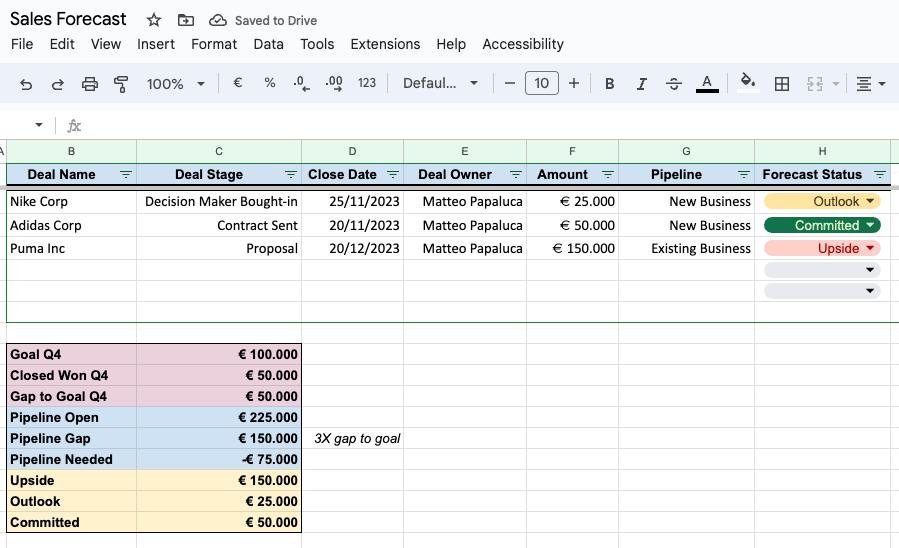Sales Forecast: The Key Aspect for Long-Lasting Success.
Today, I want to talk to you about the future. 🔮
Forecasting is one of the critical aspects of any sales team looking to build long-lasting success in the future.
Regardless of their size or stage, sales forecasting should be part of your sales playbook.
But what is Forecasting?
Forecasting is the ability of a team to give an accurate revenue estimation that they expect to close within a specific time frame.
As a Fractional Sales leader, I work with many startups, and one of the first implementations we do is sales forecast.
There are two main ways to achieve a sales forecast, and it depends on the size of your sales team.
If you lead large sales teams, look at more complex frameworks and Excel to run your forecast.
You can use past data, insights from your sales ops and, of course, your pipeline data to forecast. This can be done live or even async with Salesforce.
If you are leading sales teams in small organisations, then this is for you.
My model is tailored for small groups and companies with ARR <5M.
It's a simple framework, but...it works.
If you have known me for some time, you know I'm a big fan of 'less is more' when discussing sales.
However, I found that most CEOs, Founders and even some sales leaders don't forecast.
They think it's something for big corporations or for later stages.
But it actually isn't.
Sales teams, by definition, need directions and structure to perform.
Forcing them to sit down and commit to the deals they are working on is very important to help them grow.
To take control of your sales team, you have to start forecasting. Right now.
You can't build a forecast file with too many units because the inputs won't work.
Usually, you can forecast pipeline and closed-won, which are in the same units.
How it Works
The sales forecast is a process, usually part of a sales playbook, where a sales team sit together and reviews the deals they have open in the pipeline.
The goal is to use your CRM to forecast.
Hubspot has a forecast feature, but I'm not a fan of it.
Unfortunately, the best forecast feature I have seen is on Salesforce.
Why did I say 'unfortunately'?
Because SFDC is expensive, early-stage startups tend to start on Hubspot. Then, move on to SFDC later on.
To kick things off, you can build a simple Google Sheet feeding the data from Hubspot pipelines.
Create a personal view with the current parameters:
Deals Open
Closing this month / this quarter (depends on your forecast window).
Only select deal stages with a 50% probability of closing (past discovery, for sure).
Include also renewal and upsell and existing business pipeline.
Schedule a weekly meeting with your team at the beginning or end of the week.
Thirty minutes is usually enough.
Forecast Categories
Each deal should be assessed by the deal owner under 3 forecast categories:
Upside: the deal might come, but it's not likely to happen within the closed date. The probability is <50%.
Outlook: the deal has a 50% chance of coming within the assigned closed date
Committed: the deal is coming with a 90% chance of success.
During the meeting, have your sales team review each deal and ask for a forecast assessment.
If you need to, ask questions like: "What can prevent them from signing"? "Do you have a scheduled next step?".
Without being too aggressive, the forecast moment should be a moment of accountability.
Accountability for the team and yourself.
Allow a 5-10% error (above and below the metric), and use the same Google sheet weekly, adding one sheet at a time.
Every new week, look at the past week and give insights around:
Has the forecast decreased or increased?
What does each category look like?
How's the total number looking compared to the previous week?
Summary
You may think this isn't for you, and you are too early to start forecasting. Think again.
Forecasting is critical at any stage of your organisation, whether just starting up or scaling your sales team.
The forecast moment is a crucial moment of your week; together with coaching and 1:1s, forecasting is essential.
Make it a habit, coach and measure your team on how they do this effectively, and you are laying down the foundations of something great.
Thank you for reading this far; see you again next week. Ciao!

